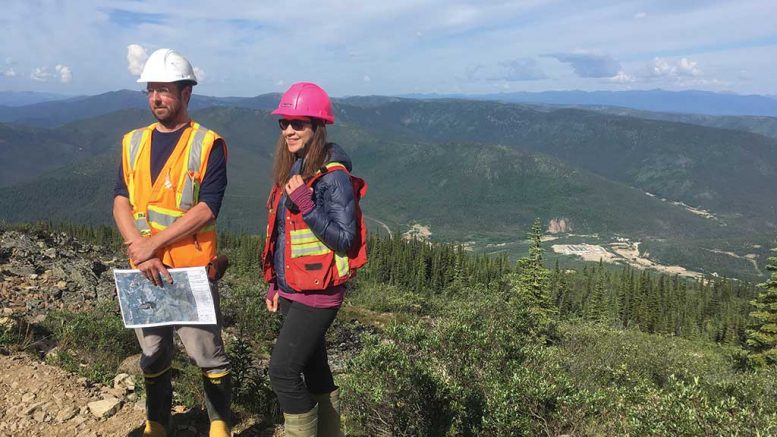The third and final day of the Canadian Mining Symposium (CMS) closed with a panel discussion featuring the Hon. Ranj Pillai, Deputy Premier, Minister of Energy, Mines and Resources and Minister of Economic Development for the Government of Yukon, and mining experts from Strategic Metals (TSXV: SMD), Alexco Resources (TSX: AXR; NYSE-MKT: AXU) and Western Copper and Gold (TSX: WRN; NYSE-MKT: WRN).
Moderating the session, building a mining ecosystem from exploration to production, was Trevor Hall, president of Clear Creek Digital, a Colorado-based social communication, and media agency specializing in digital content strategies for mining and exploration companies.
Hall kicked off the discussion by first introducing the panellists and asking Pillai to say a few words.
“I just wanted to welcome everyone to the panel today and to thank The Northern Miner for organizing the symposium,” Pillai said. “I’m here on a beautiful day in the Yukon on the traditional territory of the Kwanlin Dun First Nation and the Ta’an Kwach’an Council, I’d like to recognize that and want to acknowledge those who are joining us today.”

Two drill rigs operate at the Bermingham target. Credit Alexco Resource.
Pillai acknowledged that mining continues to be a key industry for the Yukon and has been the driver of the modern economy. He also touched upon the many advantages of the Yukon, with its abundant mineral potential, including world-class deposits and a competitive regulatory regime.
He also drew attention to the territory’s support for early-stage exploration through the Yukon Mineral Exploration Program. The program helps to shoulder a portion of the risk capital required for individuals and companies to explore and develop projects to an advanced exploration stage.
“We recently announced that we increased our funding to $2.5 million, which is the most we’ve put towards this program,” Pillai noted.
The extra funding, Pillai noted, was in recognition of the disruptions caused by the Covid-19 outbreak.”
The Yukon government, he added, is also working on a new transmission line that would “benefit some of his fellow panellists,” and $500 million in funding for new strategic infrastructure investments, including energy technologies like microgeneration, that will benefit exploration and mining companies operating in the territory.
“Over and above that, we continue to work on our $500 million portfolio around the Yukon Resource Gateway projects that will help people, particularly in the northwest part of the Yukon as well as those in the southeast,” he noted.
An agreement, he said, has been signed with the Little Salmon Carmacks First Nation on the first phase of work on the Yukon Resource Gateway project. The work will be very advantageous to companies like Western Copper and Gold.
A $71 million agreement was also signed with the River Ross Dene Council First Nation and was announced at PDAC in March, Pallai added. The agreement will upgrade roads around Fireweed’s Macmillan Pass Project, including bridge replacement and safety improvements on the North Canol Road and resurfacing of 60 km of the Robert Campbell Highway.
“We continue to ensure that we have strong government-to-government relations with the First Nation people,” Pillai said. “You have to be at the table with your partners, and it’s something that we continue to focus on.”
He concluded by reaffirming the Yukon’s mineral potential, not only for precious metals such as gold and silver, but also other minerals, including copper, zinc, nickel, tungsten, tin and cobalt.
Hall then introduced Clynton R. Nauman, chairman and CEO of Alexco Resources, to discuss the company’s background and highlight some of its recent activities.
“We own the Keno Hill Silver District, around 350 km north of Whitehorse in the traditional territory of the Na-Cho Nyak Dun First Nations,” Nauman said.
The company, he added, is advancing the project to renewed silver production with an anticipated feed grade of approximately 800 grams silver per tonne and about 7% combined lead and zinc. The mine, he said, will produce around 4 million oz. silver per year once it reaches its designed capacity of 400 tonnes per day through an existing mill.

The flotation mill at Alexco Resource’s dormant Keno Hill silver mine, 330 km north of Whitehorse, Yukon. The mill was commissioned at 407 tonnes per day and can produce
lead and zinc concentrates. Photo by Matt Keevil.
More recently, Alexco has been working on the final permit assessment and authorization to proceed to production, Nauman noted, and is hoping to secure their water license in the near term.
“Since 2019, we’ve been advancing key infrastructure at site, which once the water license is issued and, assuming a final decision by the board of directors, will allow us to produce our first concentrate in quarter four of this year, with plans to reach full capacity in the first quarter of 2021,” he added.
He concluded by adding that, as the company is a pure silver producer, it is one of the few companies in the world that has an average hit-grade of more than 800 grams silver per tonne. He expects more than 75% of the company’s revenue will come from silver and will be the only primary silver producer in Canada.
Hall then turned to W. Douglas Eaton, president, CEO, and director of Strategic Metals for an update on the company.
“We’ve been around for many years as a project generator, but last summer we made one of the most exciting gold discoveries in a long time in the Yukon,” Eaton said. “Our flagship property is called Mount Hinton, which is directly south of the Alexco ground in the Keno Hill district.”
The property, Eaton added, has bonanza-grade gold values, with assays from a soil sample containing native gold grading 2,340 grams gold per tonne. The discovery, he noted, was made at a new part of the property called the Granite Creek basin.
Although Mount Hinton is located within the world-famous Keno Hill silver mining camp, Canada’s second-largest primary silver producer, gold is the most significant component of the bedrock showings and occurrences to date, he noted.
“Around three years ago, very spectacular gold nuggets were discovered under an area covered about by 10 centimetres of glacial till,” Eaton said. “The glaciers that deposited the gold in the underlying creeks that were buried by the glacial till are draining right off the centre of the property.”
The company, he added, started work at the property a couple of days ago. Activities over the first few months will focus on improving road access, further exploration, and detailed mapping, with a 7,000-metre drilling campaign slated to begin in July.
Next, Hall spoke with Paul West-Sells, Western Copper and Gold’s president and CEO.
“We have one asset, the Casino copper-gold project located very close to Newmont’s copper project in the Yukon,” West-Sells said. “We’ve been developing this project for well over a decade now and is a large copper-gold porphyry with a total of 18 million ounces of gold and 10 billion pounds of copper.”
The project, he added, is a significant copper-gold deposit with current copper prices at over US$2.50 per lb. and gold prices high as well, the project has an after-tax internal rate of return over 25% and a net present value of around $3 billion, he said.
“Last year, we ran an infill program that hit over 3 metres grading 55 grams gold per tonne, which was in addition to a couple of historic intercepts, with one hitting 50 grams gold and another intercepting 70 grams gold,” West-Sells said.
The company also acquired the Canadian Creek property, to the west of Casino, and has several untested targets, including another porphyry target, West-Sells noted.
“We now have a district with copper porphyry targets as well as high-grade gold,” he said. “Drilling at the property started this morning, so we’re pretty excited to see the drill first results coming soon.”
Hall then started the panel discussion with a question on the various political risks associated with operating in the Yukon.
“From a geopolitical standpoint, we’re a very secure area, with eleven of our First Nations all holding modern treaty agreements,” Deputy Premier Pillai said. “So that’s a great advantage for companies looking to come into the area and for those looking to invest in the territory.”

Looking down hill towards Western Copper and Gold’s camp at the Casino project. Photo by Matthew Keevil.
The territory, he added, also has a very strong regulatory regime, which the government is looking to improve upon by updating the policy framework around water quality standards, improving adaptive management plans, and reclamation enclosure policies for quartz mining.
He also mentioned the Yukon Minerals Development Strategy. The strategy, which is being developed by the Government of Yukon and the eleven self-governing Yukon First Nations, will look to drive the long-term responsible management of Yukon’s mineral resources and support a healthy mining industry that adheres to high environmental and social standards.
Hall then asked Alexco’s Nauman to expand on his experience of the water permitting process, and when a decision will be made on production.
“Before I address that question, I think it’s important to understand the bigger context,” Nauman said. “Capital will always flow to places with the lowest sovereign risk. There is no question that Canada and the Yukon fit squarely in that category, and that sanctity of title is everything.”
He added that were many examples in the world where that sanctity is often violated and suggested that in places such as Mexico, Peru, and China that sanctity had been disrespected too many times.
Nauman then pivoted back to Hall’s question on the water licensing process.
“The water licensing process in the Yukon is a judicially fair process,” he said, “and ensures that arguments from both proponents and interveners are heard.”
However, although the timelines are well understood, the process is not as efficient it could be, he noted, but recognized that the Deputy Premier had acknowledged this and was attempting to improve it.
Hall then asked Eaton of Strategic Metals that, with all the exploration going on in the Keno Hill district, how was the deposit at Mount Hinton missed?
“That’s a good question,” Eaton said. “First and foremost, up until the last few years, the access into the Granite Creek basin has been somewhat restricted and would require four-wheel-drive vehicles. However, this has now significantly improved.”
More fundamentally, he added, the district’s host rocks are mostly tough quartzites and form huge blocks of talus that tend to be recessive and hidden by the overburden, making surface discoveries throughout the whole district very difficult.
“Also, for most of the history of the Keno Hill district, the focus was very much on silver,” Eaton noted. “It was until the 1970s that gold became the focus for prospectors.”
The final reason, he added, is that the two historic mills operating in the district were distal to the Mont Hinton property even though they were part of the same hydrothermal system. So, he said, it would have been hard for previous miners to ship materials from the property to the mills.
Hall then turned to West-Sells of Western Copper and Gold, asking him that, in light of their sizeable gold-copper deposit, was the company currently trading as a gold or copper company?
“We were certainly a gold company when gold was trading at US1,700 [per ounce] and copper at US$2.50 [per pound], but with copper trading at over US$2.60 [per pound], it’s probably 50:50 now.”
He then also pivoted back to the question of the geopolitical risks of operating within the Yukon.
“If you look at copper, a significant proportion of the world’s copper comes from Chile and Peru,” he noted. “So, a lot of the conversations we have around copper are that people like the fact that there’s copper in tier-one jurisdictions like the Yukon.”
West-Sells also noted that being both a copper and gold property provides a hedge.
“When economies are booming, copper prices tend to be high while gold prices are depressed, but when economies are struggling, copper prices hold back while gold prices are rising,” he said.
He also added that the large gold producers, such as Newmont Goldcorp (TSX: NGT; NYSE: NEM) Barrick Gold (TSX: ABX; NYSE: GOLD), are significant copper producers, too.
Hall then turned to Eaton and asked what the summer exploration at Mount Hinton will involve.
“Traditionally, we’ve followed the project generator model and been very successful at it,” Eaton said. “But the reason we’re reluctant to farm it out to other operators is that there are around 75 known vein occurrences, with nearly none of them having been drilled.”
The conversation closed with the panellists discussing the possibility of the Keno Hill district becoming another high-grade mineral resource jurisdiction, and agreed that, given the district’s underexplored nature, it could give rise to some very significant mining operations.
Then, Anthony Vaccaro, Group Publisher with The Northern Miner and Head of Global Mining for Glacier Resource Innovation Group, closed the symposium with some final thoughts on the industry and the past three days.
“The mining and exploration industry is both simultaneously vast and small,” Vaccaro noted. “It’s vast in its geographic reach and its impacts on the products that we all rely on in our everyday lives, yet for an industry that matters so much to the global economy, it’s a small industry relative to other sectors.”
However, Vaccaro added, as a small industry it is remarkably accessible.
“That accessibility is thanks, in large part, to the personalities of leaders you’ve met here over the last three days,” he said. And it permeates throughout the entire industry, which is a big checkmark in our favour.”
He closed the symposium by once again thanking the sponsors and all those who took part in this year’s event.






Be the first to comment on "Canadian Mining Symposium closes with Yukon mining panel, featuring Deputy Premier Ranj Pillai"